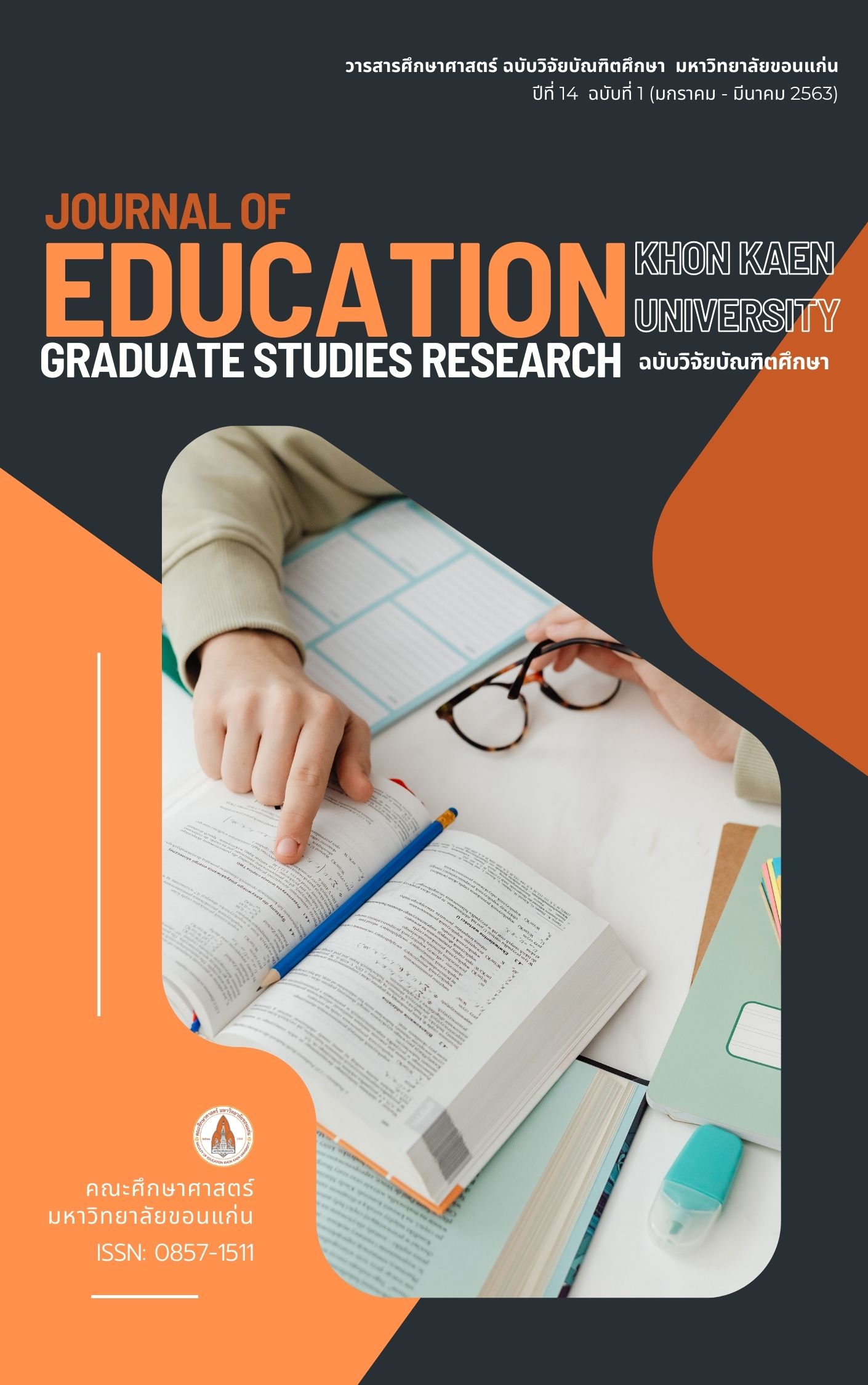A Proposed Policy for Talent Management of Basic Education Schools
Main Article Content
Abstract
This policy research aim to purpose policy recommendations talent management of Basic Education schools . Research methodology conducted by 2 phases; phase 1 study to make a propose policy for talent management of basic education schools by documents analysis, multi-case studies, and in-dept interviewing 5 experts to making the draft of policy recommendations. Phase 2 investigate policy recommendations by 5 experts were to assess the propriety, feasibility and utility of policy recommendations.
The results of the research showed that Policy recommendations for management in basic education (A Proposed Policy for Talent Management of Basic Education Schools) 1) Vision is a model for Talent Management in order to develop talented or highly qualified personnel with the highest level of evaluation in all three areas, consisting of appropriateness Propriety ( = 5.00) Feasibility (
= 5.00) and benefits (
= 5.00) are appropriate The possibility And the benefit is at the highest level 2) Mission with evaluation of suitability Propriety feasibility and the benefit is at the highest level, which has an average value of 5.00, 4.80 and 5.00 respectively, is appropriate (Propriety) possibility. And the benefit is at the highest level 3) Goals: encourage personnel to explore their aptitude And their own interests Have skills in critical thinking, creative thinking And have problem solving skills Increase knowledge and skills in operations with the evaluation of suitability, feasibility, and usefulness at the highest level. Which have the same mean (
= 5.00) 4) Objectives with the highest assessment of suitability, feasibility, and usefulness with the same average (
= 5.00) 5) Strategic suitability with the highest assessment of suitability, feasibility, and usefulness with the same average (
= 5.00) 6) Guidelines with the highest assessment of suitability, feasibility, and usefulness with the same average ( = 5.00)
Article Details
References
เจษฎา นกน้อย. (2550). การจัดการผู้มีความสามารถสูง: ปัจจัยสำคัญสู่ความได้เปรียบทางการแข่งขันขององค์การ. Chulalongkorn Review, 19(74), 43-57.
เจษฎา นกน้อย. (2552). นานาทรรศนะการจัดการความรู้และการสร้างองค์การแห่งการเรียนรู้. กรุงเทพฯ: ส.เอเซียเพลส.
คะนึงนิจ อนุ โรจน์. (2554). Approach to Talent Management. Royal Thai Airforce Medical Gazette.
ฐานิตา อ่วมฉิม และ มณฑา จำปาเหลือง. (2557). การบริหารทรัพยากรมนุษย์ที่ส่งผลต่อบรรยากาศองค์การของ สถานศึกษา ในสังกัดสำนักงานเขตพื้นที่การศึกษาประถมศึกษาประจวบคีรีขันธ์ เขต 1. Veridian E-Journal, Silpakorn University, 7(3), 272-284.
ดาวรุวรรณ ถวิลการ. (2559). กระบวนทัศน์การบริหารจัดการคนเก่งของสถานศึกษาในศตวรรษที่ 21. วารสารศึกษาศาสตร์ มหาวิทยาลัยขอนแก่น, 39(2), 15-22.
ดาวรุวรรณ ถวิลการ. (2562). ศาสตร์และศิลป์ทางการบริหารการศึกษา. ขอนแก่น: ศึกษาศาสตร์ มหาวิทยาลัยขอนแก่น.
ปฐมพงษ์ โตพานิชสุรีย์ (2553). การรักษาผู้มีผลสัมฤทธิ์สูงในองค์การ : กรณีศึกษาข้าราชการพลเรือนสามัญ. วารสารบริหารธุรกิจ, 33(127), 35-49.
ประไพวรรณ สัมมาทิตฐิ. (2552). การบริหารจัดการคนเก่ง กรณีศึกษา ธนาคารแสตนดาร์ต ชาร์เตอร์ (ไทย) จำกัด. วิทยานิพนธ์ปริญญารัฐศาสตรมหาบัณฑิต สาขาวิชาการบริหารจัดการสาธารณะสำหรับนักบริหาร บัณฑิตวิทยาลัย มหาวิทยาลัยธรรศาสตร์.
พสุธิดา ตันตราจิณ. (2559). การพัฒนาและการธำรงรักษาคนเก่งในองค์การ กลไกที่สำคัญในการขับเคลื่อนองค์การสู่ความสำเร็จ. Veridian E-Journal, Silpakorn University, 9, 1.
พัชระ งามชัด. (2561). การวิจัยและพัฒนารูปแบบการบริหารจัดการคนเก่งของสถานศึกษาขั้นพื้นฐาน. วิทยานิพนธ์ปริญญาปรัชญาดุษฎีบัณฑิต สาขาวิชาการบริหารการศึกษา บัณฑิตวิทยาลัย มหาวิทยาลัยขอนแก่น.
มาริสสา อินทรเกิด. (2560). การบริหารจัดการคนเก่ง ความท้าทายขององค์กร. วารสารธุรกิจปริทัศน์, 9(1), 279-290.
วาสิตา ฤทธิ์บำรุง. (2548). การบริหารจัดการคนเก่งเพื่อสร้างความได้เปรียบทางการแข่งขันขององค์กร. สารนิพนธ์วิทยาศาสตรมหาบัณฑิต สาขาวิชาการพัฒนาทรัพยากรมนุษย์และองค์การ บัณฑิตวิทยาลัย สถาบันบัณฑิต พัฒนบริหารศาสตร์.
วิโรจน์ สารรัตนะ. (2548). โรงเรียน: การบริหารสู่ความเป็นองค์การแห่งการเรียนรู้. พิมพ์ครั้งที่ 5. กรุงเทพฯ: อักษรา พิพัฒน์.
ศศิรัศมิ์ ประสาทแก้ว และ จรัส อติวิทยาภรณ์. (2557). ปัจจัยเชิงสาเหตุพหุระดับในการพัฒนามหาวิทยาลัยสู่องค์กร สมรรถนะสูงแบบบูรณาการพหุมิติ ศึกษากรณีมหาวิทยาลัยวลัยลักษณ์ มหาวิทยาลัยทักษิณ และมหาวิทยาลัยสงขลานครินทร์. วารสารศึกษาศาสตร์ มหาวิทยาลัยสงขลานครินทร์ วิทยาเขตปัตตานี, 25(1), 51-71.
เศรษฐวัฒน์ เอกคณานุวงศ์. (2553). การจัดการทรัพยากรมนุษย์ที่มีความสามารถพิเศษ. วิทยานิพนธ์ปริญญาปรัชญา ดุษฎีบัณฑิต สาขาวิชารัฐประศาสนศาสตร์ บัณฑิตวิทยาลัย มหาวิทยาลัยรามคำแหง
สำนักงานคณะกรรมการข้าราชการพลเรือน. (2556). รายงานประจำปีระบบข้าราชการผู้มีผลสัมฤทธิ์สูง ประจำปีงบประมาณ 2556. ค้นเมื่อ 10 พฤษภาคม 2562, จาก https://www.ocsc.go.th/sites/default/files/attachment/article/2013-hipps-annual-report-2556.pdf.
สุกัญญา รัศมีธรรมโชติ. (2554). พัฒนาดาวเด่นเพื่อองค์กรที่เป็นเลิศด้วย Talent management by competency-based career development and succession planning. กรุงเทพฯ: สถาบันเพิ่มผลผลิตแห่งชาติ.
สุพรหม ทำจะดี. (2549). การบริหารจัดการคนเก่ง. ค้นเมื่อ 14 ตุลาคม 2555, จาก http://www.person.rtaf.mi.th/ doc/content/talent_Management.pdf.
อรุณรุ่ง นันทวัฒนากูล. (2558). โมเดลการบริหารจัดการคนเก่ง คนดีของสถานประกอบการอุตสาหกรรมไฟฟ้าและอิเล็คทรอนิคส์. วารสารการจัดการธุรกิจ มหาวิทยาลัยบูรพา, 4(1), 55-71.
อัญรินทร์ฉัตร์ เบญจนันท์ และวลัยพร ศิริภิรมย์. (2558). สภาพการบริหารจัดการคนเก่งของโรงเรียนเอกชนในสมาคมโรงเรียนเอกชนจังหวัดสระบุรี. สาขาวิชาบริหารการศึกษา ภาควิชานโยบาย การจัดการและความเป็นผู้นำทางการศึกษา คณะครุศาสตร์ จุฬาลงกรณ์มหาวิทยาลัย.
อาภรณ์ ภู่วิทยพันธุ์. (2554). เทคนิค การจัดทำ แผนการสื่อสารงาน HR = HR communication. กรุงเทพฯ: เอช อาร์ เซ็นเตอร์.
Alan Robertson and Graham Abby. (2003). Managing Talented People: Getting on with – and Getting the Best from - Your High Performers. Great Britain: Pearson Education.
Berger, L. A., & Berger, D. R. (2004). The talent management handbook: Creating organizational excellence by indentifying, developing, and promoting your best people. New York: McGraw-Hill.
Brent, D., & Barbara, J. D. (2010). Talent management in academies. International Journal of Educational Management, 24(5), 418-426.
Davies, B., & Davies, B. J. (2010). Talent management in academies. International Journal of Educational Management, 24(5), 418-426.
Chowdhury, S. (2002). The Talent Era: Achieving a High Return on Talent. New York: Prentice Hall.
David, G. C., & Kamel, M. (2009). Strategic talent management : A review and research agenda. Human Resource Management Review, 19, 304-313.
Ed Michaels and Helen Handfield-Jones. (2001). The War for Talent. Harvard Business School Press Boston, Massachusetts: McKinsey & Company.
Gubman, E. L. (1998). The Talent Solution: Aligning Strategy and People to Achieve Extraordinary Results. United States: The McGraw-Hill Companies.
Kaye, T., & Andy, P. (2007). The Essential Guide to Managing Talent. Britain: Kogan Page Publishers.
Oaks, M. M. (2003). Policy Research for Educational Leader. Paper for A Two –Week. Intensive Workshop For The Second Cohort of Doctoral Student in Education Administration. Faculty of Education Khon Kaen University Thailand.
Rani, A., & Joshi, U. (2012). A Study of Talent Management as a Strategic Tool for the Organization in Selected Indian IT Companies. European Journal of Business and Management, 4(4), 20-28.
Robertson, A., & Abby, G. (2003). Managing Talented People. Britain: Pearson Education.
Schweyer, A. (2004). Talent Management Systems: Best Practices in Technology Solutions for Recruitment, Retention and Workforce Planning. Canada: John Wiley & Son.
Sears, D. (2003). Successful Talent Strategies: Achieving Superior Business Result Through Market-
Focused Staffing. New York: American Management Association.
Tyagi, S., Singh, G., & Aggarwal, T. (2017). Talent management in education sector. International Journal on Cybernetics & Informatics (IJCI), 6(1/2), 47-52.
Tashakkori, A., & Teddlie C. (1998). Mixed Methodology: Combining Qualitative and Quantitative Approaches. Thousand Oaks, CA: Sage Publications.

